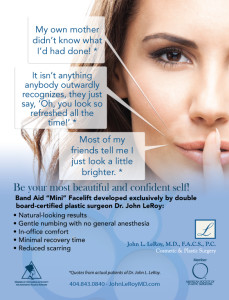Ask Dr. LeRoy: What Should I Expect on the Day of My Facelift?
Having a few butterflies in your stomach before plastic surgery is incredibly common, and in many cases, patients are simply nervous because they don’t know exactly what to expect. While there’s no replacement for actually experiencing the process for yourself, as a double board-certified plastic surgeon who has specialized in face lifts for over twenty years, I can walk you through the day of your surgery so you have a better idea of what to expect.
By the day of your procedure, you will have received plenty of specific instructions about what to avoid and how to prepare before face lift surgery. For example, when to stop smoking if you smoke, when to stop taking certain medications and supplements, when to stop eating the day of or night before surgery, etc. When you wake up on surgery day, be sure to continue following these instructions closely. You’ll put on comfortable clothing that doesn’t need to be taken off over your head, like a button-up shirt. Without applying any makeup or skin care products for the day (which is a welcome break, for some patients), you’ll also wash your face with antibacterial soap and take any pre-surgical medications you were instructed to take, like antibiotics. All of this information will be included in the pre-surgical instructions you will receive when you schedule your surgery.
When it’s Time for Surgery
When your appointment time is near, you’ll head to either my office (if you’re having a Band Aid Mini Facelift or a Band Aid Micro Mini Facelift) or to Perimeter Surgical Center, the facility where I perform traditional face lifts. Before the actual surgery begins, you’ll have some paperwork to fill out, and my nurse Dorothy will check your blood pressure and provide other preparations, including your “before” picture.
If you’re having a traditional facelift with general anesthesia (so that you will be unconscious throughout the surgery), your anesthesia will be administered before surgery by an anesthesiologist (or by a nurse anesthetist overseen by an anesthesiologist). If you’re having an in-office Band Aid Facelift, on the other hand, your surgical preparation will depend on whether you will receive only local anesthesia (gentle numbing for the treatment area) or local anesthesia with sedation as well. You and I will discuss and decide all of these details in advance at your pre-surgical consultation, so you’ll know exactly what to expect ahead of time.
Your surgical time will depend on the extent of your procedure, your unique anatomy, and a number of other factors. In general, though, a Band Aid Mini Facelift takes about an hour and a half, while a traditional face lift can take anywhere from two to four hours. Halfway through the procedure, Dorothy typically comes out to the waiting area to give an update to any friends or family members who are waiting for you. When your surgery is finished, you’ll have a dressing applied to the area to provide gentle pressure and protect your incisions. You may or may not also have a drain to release any excess fluids.
All in all, Band Aid Facelift patients typically spend a total of 2 ½ hours in our office. Face lift patients vary considerably more based on their procedure, and the process as a whole takes longer as well because these patients need more time in the recovery room to recuperate from the anesthesia before they head home. Both traditional face lifts and Band Aid Mini Face Lifts are performed on an outpatient basis, so you can look forward to spending that first night resting comfortably at home.
After Surgery
If you receive a traditional facelift or if you receive sedation for your Band Aid Mini Face Lift, you will need to have a friend or family member drive you home and stay with you for at least the first night. If you receive only a local anesthetic with no sedation, you can safely drive, although some patients still choose to have a friend or family member drive them home so they can be fully comfortable.
While there is always some discomfort associated with surgery, the pain after a facelift is generally quite bearable and can be managed with medication. Just remember to carefully follow all of the post-surgical instructions you were given ahead of time, because some over-the-counter pain relievers are not safe to take after surgery. For the most part, you should spend the rest of your surgery day relaxing comfortably, reclined at a 30- or 45-degree angle (not lying flat), and taking frequent, gentle walks to keep your circulation active.
Because I tailor the surgical process to each patient’s needs, everyone experiences their face lift in a slightly different way. But overall, my best advice for nervous patients is to find a way to relax, trust yourself that you’re well-prepared, and trust your surgeon to operate safely and successfully. For the vast majority of patients, a facelift is a rather uneventful process, ending with beautiful results that leave them feeling happier and more confident in their appearance. To get started on your facelift journey, schedule a consultation today with me, Dr. John L. LeRoy. Or, for more plastic surgery tips and information, follow me on Facebook, Twitter, and Google+.




 The simplified answer is that aging is an ongoing process. For instance, the results of a rhinoplasty (or nose surgery) will typically look the same throughout the rest of the patient’s life, because after the nose reaches its genetically-determined adult structure, it changes very little if at all. Aging, on the other hand, is inevitable and progressive throughout adulthood. So while a face lift will remove excess skin and restore a more youthful shape to the face, the existing skin will continue to lose firmness and facial tissue will continue to drop, eventually creating new wrinkles and sagging skin. You will always look younger than you would have if you had never had a
The simplified answer is that aging is an ongoing process. For instance, the results of a rhinoplasty (or nose surgery) will typically look the same throughout the rest of the patient’s life, because after the nose reaches its genetically-determined adult structure, it changes very little if at all. Aging, on the other hand, is inevitable and progressive throughout adulthood. So while a face lift will remove excess skin and restore a more youthful shape to the face, the existing skin will continue to lose firmness and facial tissue will continue to drop, eventually creating new wrinkles and sagging skin. You will always look younger than you would have if you had never had a 